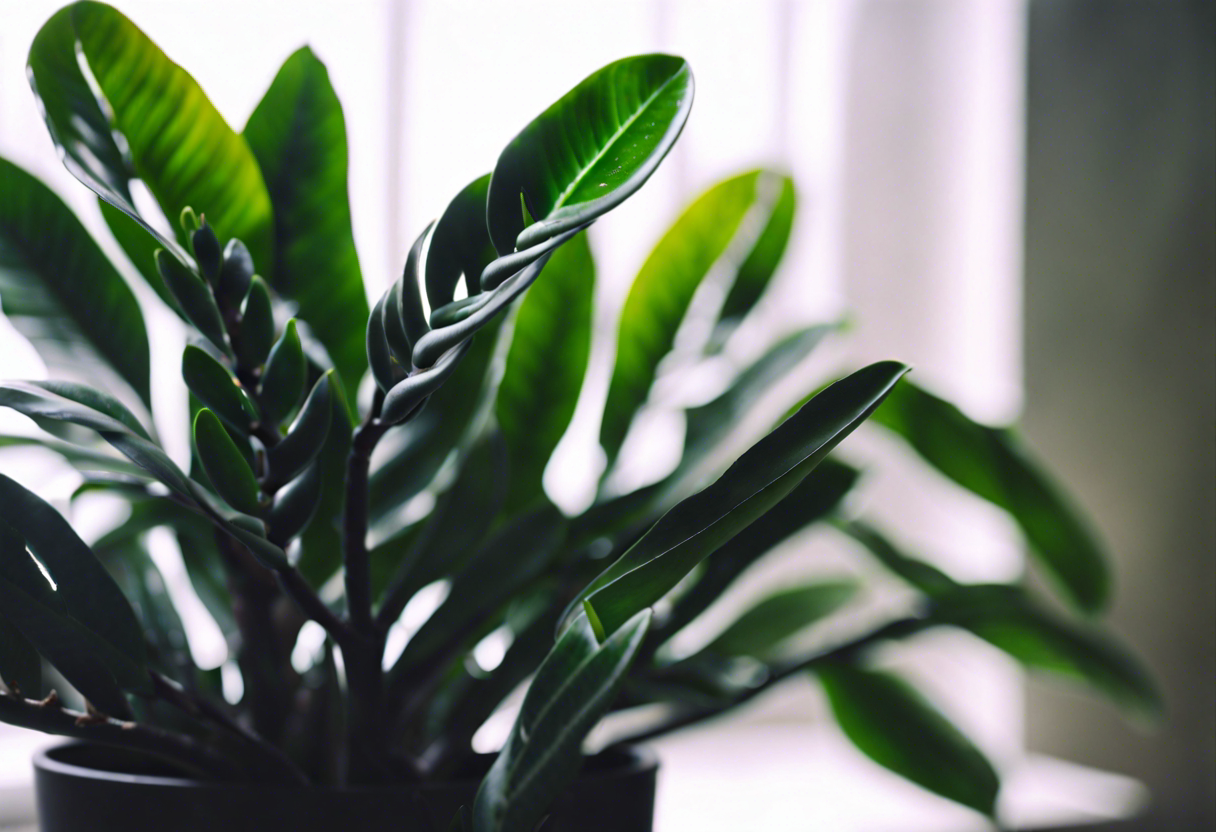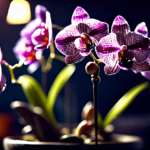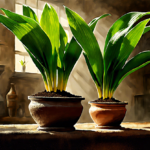Watering Techniques for ZZ Plant (Zamioculcas zamiifolia)
The ZZ Plant, scientifically known as Zamioculcas zamiifolia, is a popular houseplant appreciated for its ability to thrive in low-light conditions and tolerate neglect. However, proper watering is crucial to ensure the health and well-being of this resilient plant. Here are some essential watering techniques to keep your ZZ Plant thriving:
1. Determine the right watering frequency: ZZ Plants have thick, succulent stems and roots that store water, making them drought-tolerant. Therefore, it’s important to avoid overwatering, as this can lead to root rot. Allow the top inch of the soil to dry out between waterings. Depending on the environmental conditions, you may need to water your ZZ Plant every two to three weeks.
2. Opt for well-draining soil: The ZZ Plant prefers a well-draining soil mix that allows excess moisture to escape easily. A mixture of potting soil, sand, and perlite is recommended to provide adequate drainage. Avoid using heavy, compacted soil, as it can hold too much water and lead to root rot.
3. Water thoroughly but don’t oversaturate: When watering, ensure that water penetrates evenly through the root ball. Use enough water to saturate the soil, but avoid leaving the plant sitting in standing water. Allow the excess water to drain out completely from the pot’s drainage holes. Empty the saucer or tray beneath the pot to prevent water accumulation.
4. Consider the season and temperature: Adjust your watering frequency based on the season and temperature. During colder months or in cooler indoor environments, the ZZ Plant’s water requirements decrease. Conversely, in warmer months or if the plant is exposed to direct sunlight, it may need more frequent watering. Monitor the soil moisture regularly and adjust accordingly.
5. Observe the plant’s water needs: Each ZZ Plant may have slightly different water requirements, depending on factors such as pot size, root development, and environmental conditions. Observe the plant closely for signs of underwatering or overwatering. Yellowing leaves, mushy stems, or a foul odor can indicate excessive moisture, while drooping leaves and dry soil suggest the need for more water.
6. Use water at room temperature: Avoid using very cold or hot water when watering your ZZ Plant. Room temperature water is ideal, as extreme temperatures can shock the plant’s roots. If possible, let tap water sit for a few hours before use, allowing any chlorine or fluoride to dissipate.
7. Be cautious when watering newly propagated plants: If you have recently propagated your ZZ Plant through stem cuttings or leaf division, be extra cautious with watering. The newly propagated plants may have underdeveloped root systems, so it’s important to provide sufficient moisture without overwatering. Maintain a slightly higher humidity level around the new plants to support their growth.
By following these watering techniques, you can provide adequate moisture for your ZZ Plant while preventing common issues associated with overwatering or underwatering. Remember to assess the plant’s water needs based on its individual requirements and environmental conditions, allowing it to thrive and add beauty to your indoor space.
Understanding Light Requirements for ZZ Plant (Zamioculcas zamiifolia)
ZZ Plant (Zamioculcas zamiifolia) is known for its ability to thrive in low-light conditions, making it a popular choice for indoor plant enthusiasts. However, understanding the light requirements of this plant is essential to ensure its optimal growth and health.
ZZ Plants are native to dry regions of Africa, where they grow under the shade of tall trees. As a result, they have adapted to low-light environments and can tolerate a wide range of light conditions. While they can survive in low light, they will not thrive and may have slower growth rates. To promote healthy growth and vibrant foliage, it is recommended to provide your ZZ Plant with indirect bright light.
Ideal light conditions for ZZ Plants include placing them near a north or east-facing window. These orientations provide sufficient light without exposing the plant to direct sunlight, which can lead to leaf burn. If you have a south or west-facing window, it is advisable to place the plant a few feet away from the window or use a sheer curtain to filter the direct sunlight.
In addition to natural light sources, ZZ Plants can also adapt to artificial light. They can be placed near fluorescent lights or LED grow lights, which provide the necessary light spectrum for plant growth. When using artificial lights, it is important to position them at an appropriate distance from the plant to prevent heat damage.
It is important to note that ZZ Plants can tolerate low-light conditions, but they may become leggy and have less compact growth. If your ZZ Plant starts to stretch or lean towards the light source, it is an indication that it is not receiving adequate light. In such cases, consider repositioning the plant closer to a light source or providing supplemental lighting.
On the other hand, exposing ZZ Plants to direct sunlight can lead to leaf scorching and damage. Signs of sunburn include yellow or brown patches on the leaves. If your plant shows signs of sunburn, move it to a more shaded location and trim off any damaged leaves.
By understanding the light requirements of ZZ Plants, you can ensure their optimal health and growth. Providing them with indirect bright light or artificial light sources will help them thrive and maintain their characteristic glossy green foliage. Remember to monitor your plant’s response to light and make necessary adjustments to ensure its well-being. With proper light care, your ZZ Plant will continue to be a beautiful and resilient addition to your indoor plant collection.
Soil type and preparation for ZZ Plant (Zamioculcas zamiifolia)
To ensure the healthy growth and development of your ZZ Plant (Zamioculcas zamiifolia), proper soil type and preparation are essential. The right soil conditions provide the necessary nutrients, aeration, and drainage for the plant to thrive. Here are some important guidelines for selecting and preparing the soil for your ZZ Plant.
Choosing the right soil:
ZZ Plants prefer a well-draining soil mixture that retains moisture without becoming waterlogged. A good potting mix for ZZ Plants can be a combination of peat moss, perlite, and normal garden soil. This mixture ensures proper water retention while preventing excess moisture from causing root rot.
Preparing the soil:
Before potting your ZZ Plant, it is crucial to prepare the soil appropriately. Start by selecting a container with drainage holes to prevent water accumulation. Place a layer of small rocks or broken pottery pieces at the bottom of the pot to enhance drainage.
Next, fill the pot with the prepared soil mixture. Ensure the soil is evenly distributed, leaving enough space for the ZZ Plant’s roots. Gently pat down the soil to remove air pockets and stabilize the plant.
Maintaining soil moisture:
ZZ Plants prefer slightly moist soil, but overwatering can harm their roots. To maintain optimal soil moisture, water the plant thoroughly when the top inch of soil feels dry to the touch. Avoid leaving the plant in standing water, as it can lead to root rot.
Fertilizing the soil:
ZZ Plants do not require excessive fertilization. In fact, they can thrive in nutrient-poor soil. If you choose to fertilize, opt for a balanced, water-soluble fertilizer and follow the manufacturer’s instructions for application. Over-fertilization can lead to leaf burn and other plant health issues.
Repotting the ZZ Plant:
As the ZZ Plant grows, it may require repotting to provide sufficient space for the expanding roots. Repotting should be done every two to three years, preferably in spring or early summer. Use a slightly larger pot and follow the same soil preparation process as mentioned earlier.
Selecting the right soil type and preparing it appropriately are crucial for the optimal growth of your ZZ Plant. By choosing a well-draining soil mixture, maintaining proper soil moisture, and avoiding excessive fertilization, you can create a favorable environment for your ZZ Plant to flourish. Remember to repot the plant when necessary to accommodate its growing roots. With proper soil care, your ZZ Plant will thrive and bring beauty to your indoor or outdoor space.
Pruning and Propagating ZZ Plant (Zamioculcas zamiifolia)
Pruning and propagating ZZ Plant (Zamioculcas zamiifolia) are important tasks to maintain its health and appearance. Pruning helps to remove dead or damaged leaves, stimulate new growth, and shape the plant. Propagation allows you to create new ZZ plants from existing ones, giving you more options for expanding your collection or sharing with others. Here are some guidelines for successfully pruning and propagating ZZ Plant.
Pruning
-
Tools: Before you start pruning, make sure you have a pair of clean, sharp pruning shears or scissors. This will ensure a clean cut and minimize the risk of spreading diseases.
-
Dead or damaged leaves: Begin by removing any dead or yellowed leaves from the plant. These leaves are no longer contributing to the plant’s overall health and appearance.
-
Overgrown stems: ZZ plants can develop long, leggy stems over time. To maintain a compact and bushy shape, you can prune these stems by cutting them back to a desired length. Make the cut just above a node, which is the point on the stem where leaves emerge. This will encourage new growth.
-
Cut back long leaves: If the leaves of your ZZ plant have become excessively long, you can trim them to a more manageable length. Cut the leaf blade back by a few inches, again making the cut just above a node.
-
Propagation: Pruning provides an opportunity for propagation. Once you have pruned a stem, you can use it to create a new plant. Allow the cut end to dry and callus for a few days to reduce the risk of rot. Then, place the stem in a well-draining potting mix. Keep the soil lightly moist and provide indirect light until new growth appears.
Propagating
-
Stem cuttings: Pruning provides an excellent source of stem cuttings for ZZ plant propagation. Select a healthy stem with several nodes and cut it into sections, each containing one or two nodes. Remove the lower leaves from the cuttings, leaving a few leaves at the top. Plant the cuttings in a well-draining potting mix, burying the lower node(s) in the soil. Keep the soil lightly moist and provide indirect light. Rooting should occur within a few weeks.
-
Division: Another method of propagating ZZ plants is through division. Carefully remove the plant from its pot and gently separate the rhizomes into smaller sections. Each section should have healthy leaves and roots attached. Plant these divisions in separate pots with fresh potting mix. Water lightly and provide indirect light. The new plants should establish roots and continue to grow.
By following these pruning and propagating techniques, you can keep your ZZ Plant healthy and vibrant. Experimenting with different pruning styles and propagation methods can also add diversity to your collection. Enjoy the process of nurturing and expanding your ZZ Plant family!
Common Pests and Diseases Affecting ZZ Plant (Zamioculcas zamiifolia)
ZZ Plants (Zamioculcas zamiifolia) are known for their resilience and ability to thrive in various conditions. However, like any other houseplant, ZZ Plants are not immune to pests and diseases. Understanding the common issues that can affect ZZ Plants is essential for their care and maintenance. In this guide, we will discuss some of the most common pests and diseases that can impact ZZ Plants and how to effectively combat them.
1. Spider Mites
Spider mites are tiny pests that can cause significant damage to ZZ Plants if left untreated. These pests are challenging to detect as they are extremely small and often hide under the leaves. Spider mites feed on plant sap, leading to yellowing and browning of leaves. To get rid of spider mites, wipe the leaves with a damp cloth regularly to remove any eggs or pests. In severe cases, use an organic insecticidal soap or neem oil spray to control the infestation.
2. Mealybugs
Mealybugs are another common pest that can infest ZZ Plants. These soft-bodied insects are often found in clusters in leaf joints and under the leaves. If left unmanaged, mealybugs can cause stunted growth, yellowing of leaves, and weak plant health. To eliminate mealybugs, manually remove them using a cotton swab dipped in rubbing alcohol. You can also use organic insecticidal soaps or neem oil sprays to control the infestation.
3. Scale Insects
Scale insects are small, oval-shaped pests that attach themselves to the stems and leaves of ZZ Plants. They form a protective shell-like covering, making them difficult to remove. Scale infestations can lead to weakened plant health and yellowing of leaves. The best way to remove scale insects is to scrape them off gently with a soft brush or cloth. Additionally, you can use insecticidal soaps or horticultural oils to control the infestation.
4. Root Rot
Root rot, caused by overwatering or poorly draining soil, can be a common problem for ZZ Plants. Excessive moisture in the soil promotes the growth of fungi, which attacks the roots and causes them to rot. To prevent root rot, ensure that the soil is well-draining and watering is done sparingly. Allow the soil to dry partially between waterings, and remove any excess water from the saucer or pot tray.
5. Leaf Yellowing and Browning
Yellowing and browning of leaves can occur due to various reasons, including overwatering, underwatering, excessive sunlight, or nutrient deficiencies. It is important to assess the specific cause of leaf discoloration and take appropriate action. Adjust watering habits, provide adequate light conditions, and ensure proper nutrient levels to address leaf yellowing or browning.
By being aware of these common pests and diseases that can affect ZZ Plants, you can effectively prevent and manage any issues that arise. Regular inspection, maintaining proper environmental conditions, and implementing suitable pest control measures will help keep your ZZ Plants healthy and thriving. Remember to always use organic methods whenever possible to minimize harm to the plant and the environment.
Conclusion
In order to successfully care for a ZZ Plant (Zamioculcas zamiifolia), it is crucial to understand and implement proper watering techniques. Overwatering can lead to root rot, so it is important to let the soil dry out between waterings. It is recommended to water the plant thoroughly, allowing the excess water to drain away, and then wait for the top inch of soil to dry out before watering again. This will mimic the plant’s natural habitat in drought-prone regions, ensuring its overall health and vitality.
Another vital aspect of ZZ Plant care is providing the appropriate amount of light. These plants thrive in bright, indirect light, making them suitable for various indoor environments. Placing them near east or west-facing windows can provide them with the ideal amount of sunlight. However, they can also tolerate lower light conditions, making them perfect for offices or areas with limited natural light. Avoid exposing ZZ Plants to direct sunlight, as it can scorch their leaves.
The right soil type and preparation are paramount for ZZ Plant growth and vitality. These plants prefer well-draining soil, as sitting in waterlogged soil can cause root rot. A mixture of peat moss, perlite, and regular potting soil can create the ideal soil composition for ZZ Plants. Additionally, adding a layer of small rocks or gravel at the bottom of the pot can help enhance drainage and prevent water accumulation.
Pruning and propagating ZZ Plants can be beneficial for their overall appearance and growth. Regular pruning can help maintain a compact and bushy shape while removing any dead or yellowed leaves. To propagate ZZ Plants, the rhizomes can be divided and potted separately. Make sure each division has healthy roots and at least one or two stems. By propagating ZZ Plants, you can expand your collection or share them with fellow plant enthusiasts.
While ZZ Plants are generally hardy and disease-resistant, they can still encounter common pests and diseases. Spider mites, mealybugs, and aphids are some of the pests that can infest ZZ Plants. Regularly inspecting the leaves for any signs of pests and wiping them off with a damp cloth can help prevent infestations. Additionally, maintaining good air circulation around the plant can deter pests. ZZ Plants can also be affected by fungal diseases, such as root rot. Proper watering techniques and well-draining soil can prevent such issues. If necessary, applying a fungicide can help control fungal infections.
By understanding and implementing the proper care techniques discussed above, you can ensure the health and vitality of your ZZ Plant (Zamioculcas zamiifolia). From proper watering and light requirements to soil preparation, pruning, propagation, and pest management, each aspect contributes to the overall well-being of this stunning houseplant. With its attractive glossy leaves and low-maintenance nature, the ZZ Plant can be a beautiful addition to any indoor space, bringing a touch of greenery and freshness to your surroundings.


